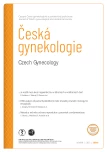DNA analysis of partial hydatidiform mole revealing triandric monogynic tetraploidy
Authors:
Lajos Gergely 1,2
; Miroslav Korbeľ 2,3
; Vanda Repiská 1,2
; Ľudovít Danihel 2,4; J. Hutník 1; Liam McCullough 2,3
; Petra Priščáková 1,2
Authors place of work:
Institute of Medical Biology, Genetics and Clinical Genetics, Faculty of Medicine, Comenius University Bratislava, Bratislava, Slovak Republic
1; Centre for Gestational Trophoblastic Disease of Slovak Republic, Bratislava, Slovak Republic
2; 1st Department of Gynaecology and Obstetrics, Faculty of Medicine, Comenius University Bratislava, Bratislava, Slovak Republic
3; Institute of Pathological Anatomy, Faculty of Medicine, Comenius University Bratislava, Bratislava, Slovak Republic
4
Published in the journal:
Ceska Gynekol 2023; 88(6): 446-449
Category:
Kazuistika
Summary
The authors present a case of a partial hydatidiform mole where DNA analysis (STR – short tandem repeat genotyping) showed a triandric monogynic tetraploid genome composition with a XXXY gonosomal complement. This genetic finding clinicopathologically correlates with a partial hydatidiform mole, although it is rare in comparison with the typical, diandric monogynic triploid partial moles. The genetic analysis definitively confirmed the suspected diagnosis of a partial mole. To exclude the possibility that molar pregnancy represented retained products of conception after elective pregnancy termination, STR profiles from molar pregnancy and previous products of conception were compared. Short tandem repeats genotyping is a useful molecular genetic method in the differential diagnosis of partial hydatidiform moles, where clinical-pathological findings are frequently ambiguous.
Keywords:
Tetraploidy – DNA analysis – partial hydatidiform mole – short tandem repeat genotyping – retained product of conception
Zdroje
1. Bynum J, Batista D, Xian R et al. Tetraploid partial hydatidiform moles: molecular genotyping and determination of parental contributions. J Mol Dia gn 2020; 22 (1): 90–100. doi: 10.1016/j.jmoldx.2019.09.006.
2. Xing D, Adams E, Huang J et al. Refined dia g – nosis of hydatidiform moles with p57 immunohistochemistry and molecular genotyping: updated analysis of a prospective series of 2217 cases. Mod Pathol 2021; 34 (5): 961–982. doi: 10.1038/s41379-020-00691-9.
3. Heřman J, Rob L, Robová H et al. Histopathological and clinical features of molar pregnancy. Ceska Gynekol 2019; 84 (6): 418–424.
4. Meng Y, Yang X, Yin H. Application of short tandem repeat (STR) genotyping in partial hydatidiform mole. Am J Transl Res 2023; 15 (5): 3731–3738.
5. Murphy KM, Descipio C, Wagenfuehr J et al. Tetraploid partial hydatidiform mole: a case report and review of the literature. Int J Gynecol Pathol 2012; 31 (1): 73–79. doi: 10.1097/PGP.0b 013e31822555b3.
6. Fisher RA, Maher GJ. Genetics of gestational trophoblastic disease. Best Pract Res Clin Obstet Gynaecol 2021; 74: 29–41. doi: 10.1016/ j.bpobgyn.2021.01.004.
7. Zavadil M, Feyereisl J, Krofta L et al. New dia g nostic approach to different hydatidiform mole types, hydropic abortions and relevant clinical management. Ceska Gynekol 2009; 74 (3): 177–182.
8. Gergely L, Gbelcová H, Repiská V et al. Importance of the genetics in the diagnostics of hydatidiform mole. Ceska Gynekol 2020; 85 (4): 275–281.
Štítky
Detská gynekológia Gynekológia a pôrodníctvo Reprodukčná medicínaČlánok vyšiel v časopise
Česká gynekologie

2023 Číslo 6
- Ne každé mimoděložní těhotenství musí končit salpingektomií
- Mýty a fakta ohledně doporučení v těhotenství
- I „pouhé“ doporučení znamená velkou pomoc. Nasměrujte své pacienty pod křídla Dobrých andělů
- Gynekologické potíže pomáhá účinně zvládat benzydamin
- Jak podpořit využití železa organismem bez nežádoucích účinků
Najčítanejšie v tomto čísle
- Diagnostika a léčba endometriózy: Doporučený postup Sekce pro léčbu endometriózy ČGPS ČLS JEP
- Preeklampsie a diabetes mellitus
- Asistovaná aktivace oocytů
- Je rozdíl mezi akutní appendicitou u těhotných a netěhotných žen?
